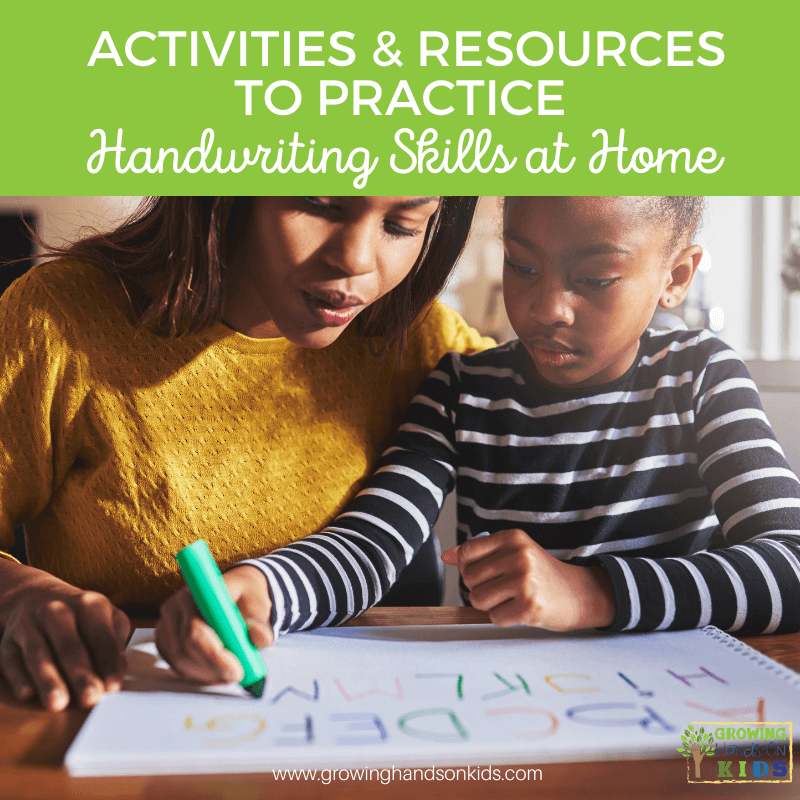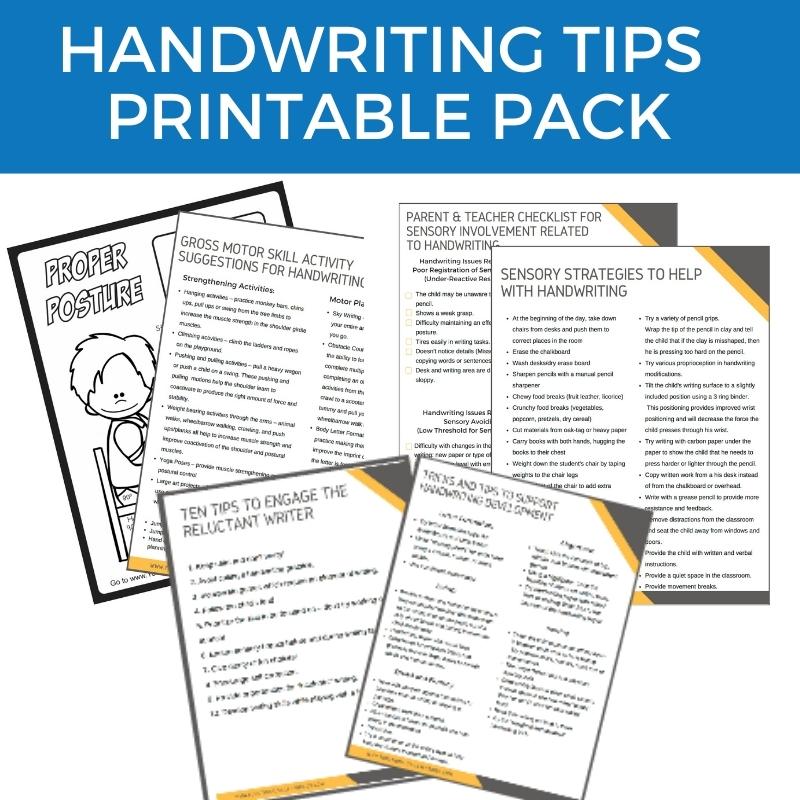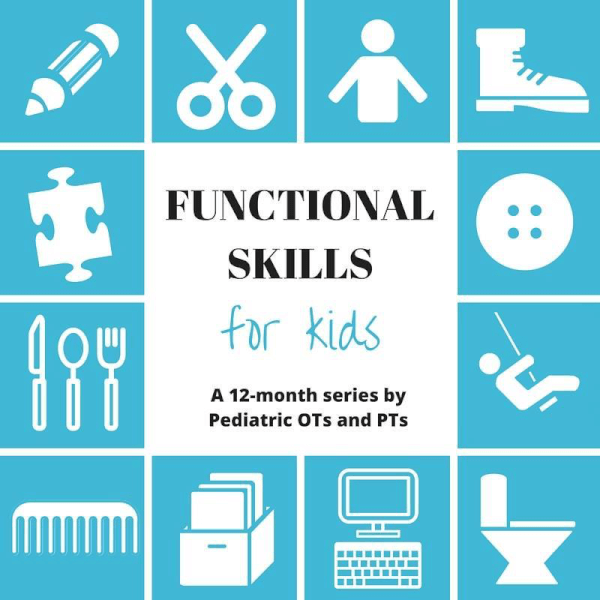Activities And Resources To Practice Handwriting Skills At Home
Affiliate and Referral links are used below to promote products I love and recommend. I receive a commission on any purchases made through these links. Please see my disclosure policy for more details. As an Amazon Associate, I earn from qualifying purchases.
Handwriting is one life skill that children develop over time. Fortunately, there are lots of other activities and resources where parents can help their child practice and improve their handwriting at home. Check out these suggestions here.
If your child is attending therapy services to work on any type of functional skills, the best thing you can do as a parent to help carry over those skills is to follow through at home. While getting help from a professional has many many benefits, you will not see the best results unless you help your child continue those skills in a home environment.

Handwriting Practice At Home – Table of contents
Should kids practice handwriting every day?
In an ideal world, YES! Handwriting practice should be done every day, but it doesn't have to be hard. In fact, just 15-20 minutes of practice a day is great.
You might be thinking that working on handwriting with a worksheet for 20 minutes a day sounds boring. And you're probably right.
Adding in hands-on activities and focusing on fine motor, gross motor, and visual-motor activities BEFORE using a worksheet is a great way to start.
There are also many ways you can adapt handwriting worksheets to be more hands-on, instead of just with a pencil or crayon.
Things to keep in mind when your child is practicing their handwriting:
- Do they have a good position at a chair/table? Are their feet flat on the floor and are they sitting up straight or are they slouching? If they are having trouble sitting upright for any period of time, add in some gross motor activities and exercises to focus on core strength and positioning.
- Are they using the appropriate writing utensil? Most children will benefit from using a small golf size pencil, especially in Kindergarten. If they are using a crayon, you can break the crayons in half. This is helpful if they are having trouble holding the pencil appropriately. More on pencil grasp here.
- Are they using proper letter formation, size, spacing, and line placement?
Activities to Practice Handwriting Skills at Home
There are so many ways you can support handwriting skills at home. Here are a few ideas to get you started.
1. Handwriting warm-up exercises
Warm-up exercises are a great way to get the arms and hands ready for handwriting practice. Not only do they warm the muscle groups they also help facilitate gross motor and fine motor strengthening of the arms, hands, and fingers.
More ideas are below:
- Handwriting Warm-Up Exercises for Little Hands – Sugar Aunts
- Handwriting Warm-Up Exercises – Pediatric Occupational Therapy Tips
- 5 Easy Fine Motor Warm-ups for Handwriting – Handwriting with Katherine
2. Use everyday activities to practice handwriting
Here are some fun ways to work on handwriting throughout the day:
- Make a grocery list
- Keep a personal journal
- Write a letter to a friend, pen-pal, or classmate
- Write out their schedule for the day (if they use a first/then schedule or visual schedule, they can write on the labels for each activity and transition)
3. Use hands-on activities for reluctant writers
There are a lot of ways to practice the basics of handwriting skills without using paper or pencil, especially if you have a reluctant writer on your hands. Sensory activities and fine motor activities that focus on using a pincer grasp on objects are great ways to involve handwriting skills in a non-conventional way. Here are some simple ideas to get you started:
- Sensory writing bags
- Using sand, cornmeal, salt, or other fine sensory mediums and then using a paintbrush or fingers to write in
- Using WikkiStix to form letters
- Play dough and play dough mats
- Writing in shaving cream or whipped cream (if you have a child who likes to taste things)
- Using clothes pins, tongs, or bubble tongs to transfer items (this fine motor tools set is perfect)
- Squeezing a glue bottle, hole punch, stapler, or turkey baster for activities
Additional resources: 12 Fun Ways to Practice Handwriting for Preschoolers
4. Handwriting apps for additional practice
There are some great handwriting apps out there and technology can have its place in handwriting practice. I always use apps as additional help, especially for letter formation practice.
What I would recommend is if you add a handwriting app into your child's handwriting routine, get a stylus for them to hold while using the tablet or iPad, instead of using their index finger. This will help promote a functional grasp of writing utensils.
A few of my favorite apps include:
Homer Learning App – comes with a 30-day free trial and includes a letter formation practice section, in addition to math, reading, and emotional learning strategies
LetterSchool by LetterSchool – this app has been a staple for me for years. It includes numbers, uppercase, and lowercase letters of the alphabet. There is also a cursive writing version. This app is free.
Wet-Dry-Try App from Learning Without Tears® – This app is $4.99, but if your child is using Learning Without Tears at therapy or in the classroom, I would recommend getting this app for home.
As a final note
It is always important to use the same types of handwriting items or materials that your child is using in therapy at home. Whether that is adaptive paper, a special pencil grip, or an elevated surface, try to recreate what your Occupational therapy practitioner is using with your child at home.
Be sure to ask your child's therapist what they would recommend you to use at home and any types of DIY adaptation you can make with things around your house instead of purchasing equipment.
Some of my favorite resources for handwriting adaptive equipment and materials are below:
- Therapy Shoppe – Their handwriting section is full of handwriting adaptations at affordable prices.
- Handwriting Tools on Amazon – This goes to my Amazon storefront page for handwriting tools
- Check your local Walmart or Target for handwriting tool options in the Crayola® aisle or educational/school supply isles
Don't forget to check out all the other posts in this month's Functional Skills for Kids topic of Handwriting.
Fine Motor Requirements for Handwriting | Therapy Fun Zone
Gross Motor Skills and Handwriting | Your Therapy Source
Sensory Processing & Handwriting Skills | The OT Toolbox
Activities to Practice Handwriting Skills at Home | Growing Hands-On Kids
Visual Perceptual Skills Required for Handwriting | Your Kids OT
Handwriting Development, Sizing, Spacing & More | The Inspired Treehouse
Handwriting Tips Activity Packet

This handwriting printable packet contains strategies to tackle many prerequisite skills children need for handwriting success.
6 printable pages of handwriting strategies including sensory strategies, handwriting tips, and gross motor activities to support handwriting.

Heather Greutman, COTA
Heather Greutman is a Certified Occupational Therapy Assistant with experience in school-based OT services for preschool through high school. She uses her background to share child development tips, tools, and strategies for parents, educators, and therapists. She is the author of many ebooks including The Basics of Fine Motor Skills, and Basics of Pre-Writing Skills, and co-author of Sensory Processing Explained: A Handbook for Parents and Educators.


Love the ideas that don’t require pencil and paper. Here are 10 simple games to play at home to practice handwriting and drawing http://yourtherapysource.com/blog1/2014/12/21/10-simple-drawing-and-handwriting-games/
The warm up activities are definitely a great idea for getting little hand muscles ready aren’t they! great post!! Anna:-)
Thank you for these ideas! It is SO important for parents to carryover and follow through with home programs. Great post 🙂
This is a great post, Heather! It is so important for parents to follow through at home.
These are such great ideas to share with parents! So many fun ways to make handwriting more interesting and appealing to kids!
I love incorporating handwriting practise into everyday activities! Working on those non-pencil/paper tasks is great motivation for lots of kids too! Thanks for sharing this.
So great for parents to have some more ideas for how to incorporate handwriting practice at home. I especially love #2 with doing things like making a grocery list, Christmas wish list, birthday wish list, birthday card for someone, or even a letter or picture to a friend or family member (works great with practice typing skills, too!).
Thank you for such a comprehensive post to help parents bridge the gap from therapy to home!
These are such great ideas!! Handwriting can be totally boring for a child, but these make it fun, engaging, AND beneficial! Definitely something to keep in mind as my son grows. Thanks for sharing <3